Renewable fuel statistics 2020: Fourth provisional report
Published 5 May 2021
About this release
This quarterly release covers the supply of renewable fuel in 2020, based on data available on 24 March 2021 which has been reported under the Renewable Transport Fuel Obligation (RTFO). Data can be supplied up to 5 months after the end of the year. Therefore, this report contains an incomplete dataset for the year so far and should be read as provisional. The final report for 2020 is scheduled for release in November 2021.
Renewable fuels are produced from biomass or some other renewable energy source. They are often blended with conventional fuels such as petrol or diesel, but they produce lower greenhouse gas emissions as their energy is from renewable sources.
In 2020:
- 2,499 million litres equivalent (eq.) of renewable fuel gas been supplied, which constitutes 6% of total road and non-road mobile machinery fuel for the year
- 1,887 million litres eq. (75%) has been verified so far under the Renewable Transport Fuel Obligation (see Background Information)
- Of this 1,887 million litres eq., an average greenhouse gas (GHG) saving of 82% was achieved when compared to fossil fuel use. This drops to 77% when indirect land-use change is accounted for
- 13% of all verified renewable fuel supplied to the UK in this period was produced from UK origin feedstocks
Figure 1: Volume of verified renewable fuel by fuel type (Table RF_0105a)
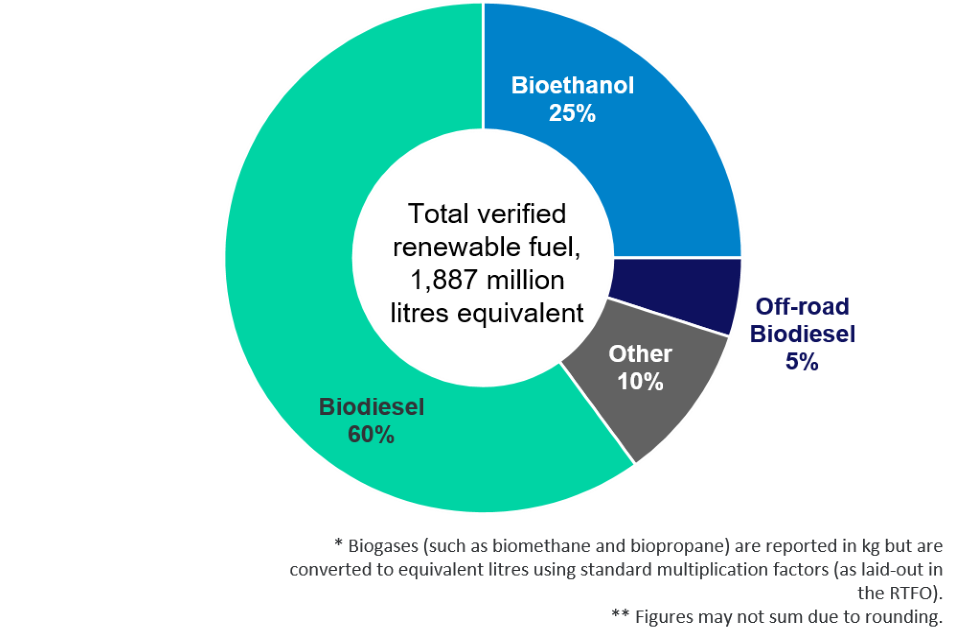
Of the 1,887 million litres eq. of renewable fuel verified so far in 2020, biodiesel comprised 60% of supply, and bioethanol 25%. There were also small amounts of other renewable fuels including biomethanol, biomethane, off-road biodiesel and biopropane.
Overview
Figure 2: What is a renewable fuel?
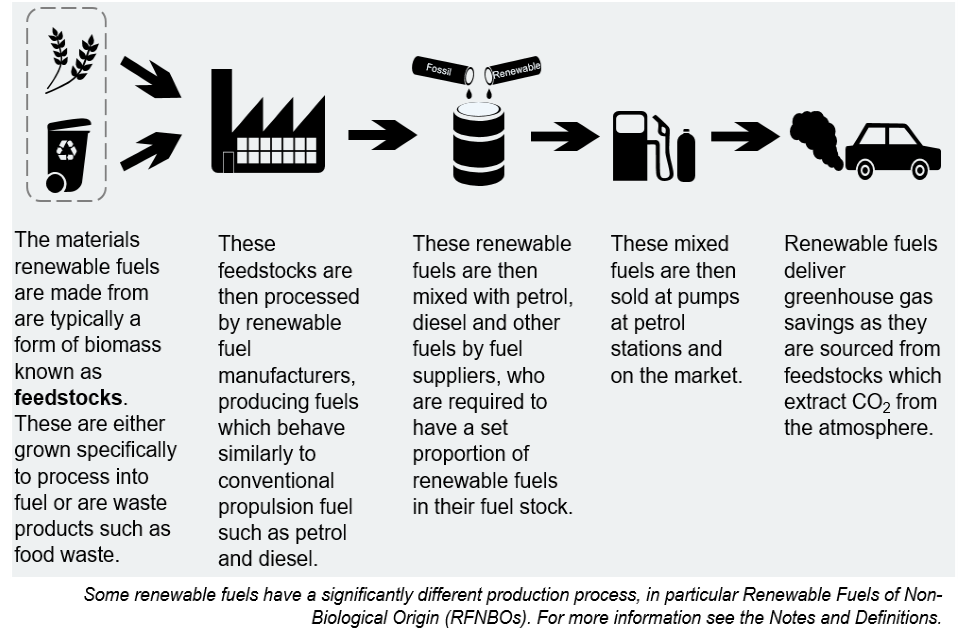
Figure 3: Highlights - 2020
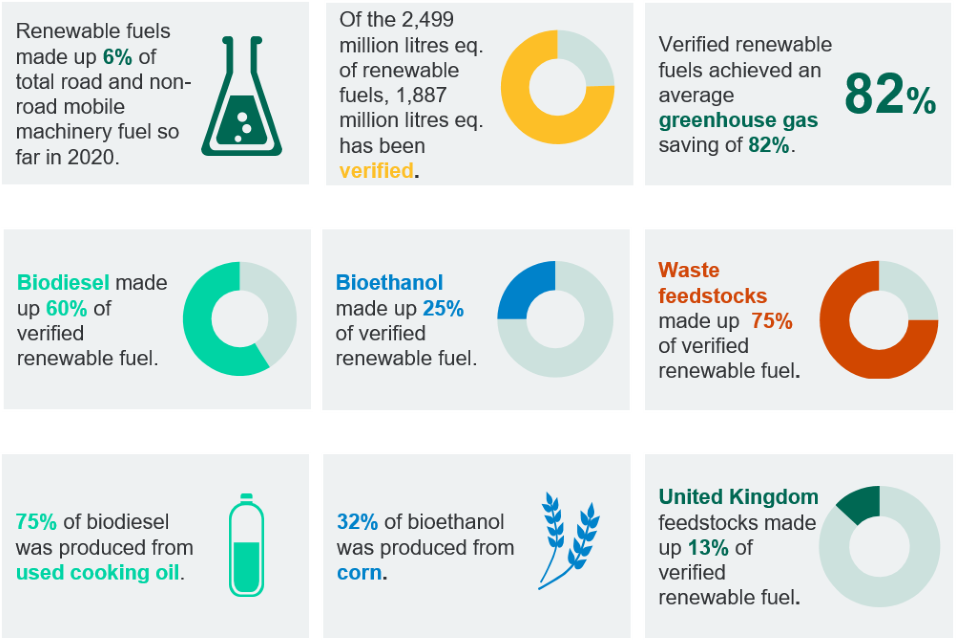
Greenhouse Gas Savings
Greenhouse Gas Savings - GHG savings represent the difference in GHG emissions between using renewable fuel as opposed to the conventional fuel they replace. The Motor Fuel GHG Emissions Reporting Regulations set obligations for fuel suppliers to reduce their average GHG intensity.
Indirect Land Use Change (ILUC) - Relates to the unintended consequences of changing land use for renewable fuel production. For example, the expansion of crop land for feedstocks driving deforestation elsewhere. This reduces the GHG savings from the renewable fuel produced.
Renewable fuels in the UK fuel supply achieved an aggregated greenhouse gas (GHG) saving of 82% compared to fossil fuels. Accounting for emissions from indirect land-use change (ILUC) reduces this GHG saving to 77%.
Under the GHG Reporting Regulations, in 2020 fuel suppliers are obligated to achieve an average 6% reduction in GHG emissions for this total fuel supply, compared to a baseline set in the Regulations. So far in 2020, there has been a 5.1% reduction, this includes Upstream Emission Reductions (UERs), electricity and renewable fuels. This figure is expected to increase as more renewable fuel is verified.
Waste feedstocks
Waste feedstocks made up over three quarters (75%) of all verified renewable fuel so far this year. Waste feedstocks have been used more in biodiesel production (90%) than in bioethanol production (28%).
Figure 4: Proportion of waste and non-waste feedstocks amongst verified renewable fuel (Table RF_0105a)
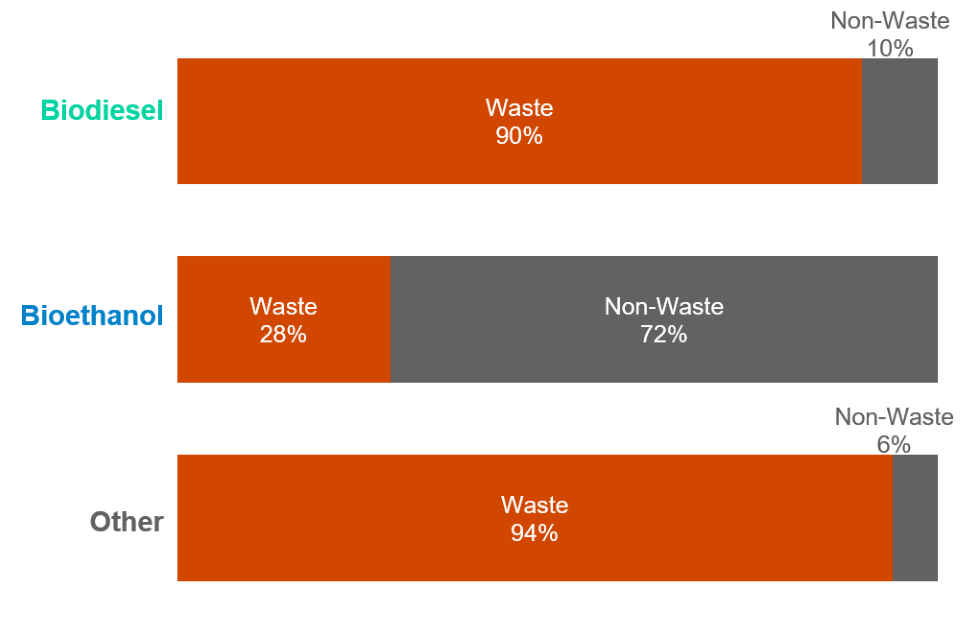
Renewable fuel produced from waste feedstocks typically delivers greater GHG savings than fuel derived from feedstocks produced specifically to be made into renewable fuel. Therefore, they are encouraged under the RTFO and are typically awarded double certificates. Waste feedstocks include used cooking oil, municipal organic waste, waste agricultural products such as corn husks, and sewage sludge.
Feedstocks
Feedstocks - Any renewable resource that can be used directly as an energy source, or converted to a transport fuel or other energy product.
The majority (52%) of all verified renewable fuel was produced from used cooking oil (UCO), which is used in several different types of renewable fuel. UCO comprised 75% of biodiesel. For bioethanol, the most common feedstock was corn (32%). Corn-based bioethanol comprised 8% of total renewable fuel.
Figure 5: Supply of verified renewable fuel to the UK by feedstock and fuel type (Table RF_0105a)

Of the 246 million litres eq. of verified renewable fuel produced from UK origin feedstock, the most common by feedstock and fuel type was bioethanol from wheat (57.2 million litres, 23% of renewable fuel from UK origin feedstock). The most common source of biodiesel from UK origin feedstock was used cooking oil (57.0 million litres, 23% of renewable fuel from UK origin feedstock).
Figure 6: UK origin verified renewable fuel by feedstock (Table RF_0105a)
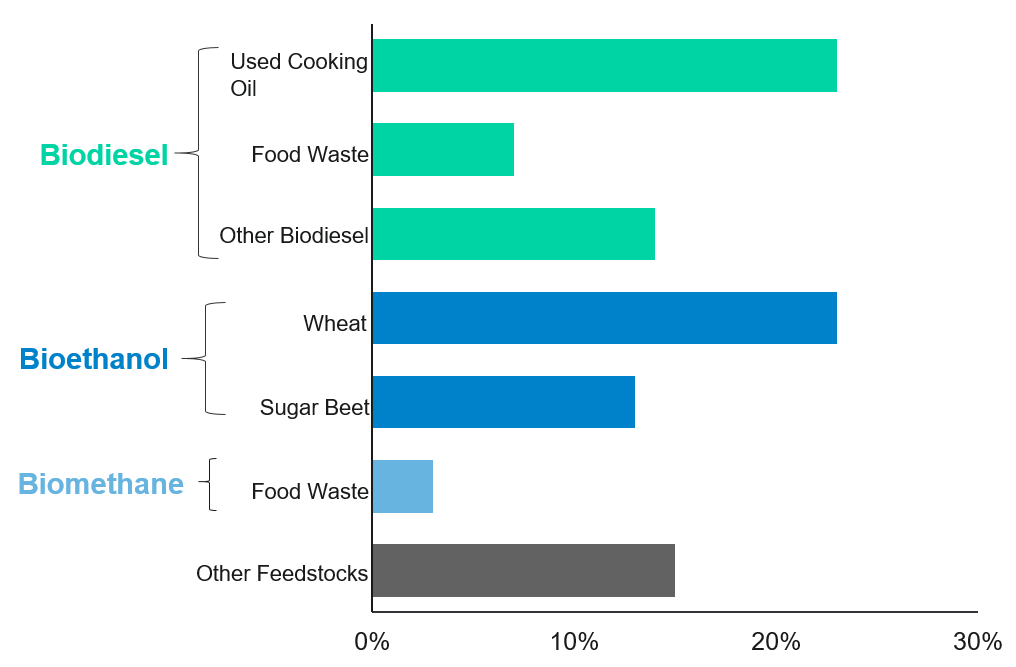
Country of Origin
UK origin feedstocks made up 13% of verified renewable fuel supplied to the UK so far this year. The top 5 feedstock origin countries together account for 56% of renewable fuel.
Of the 1,887 million litres eq. of verified renewable fuel supplied so far in 2020, the most widely reported source for biodiesel supplied to the UK (by feedstock and country of origin) was used cooking oil from China (378 million litres, 23% of renewable fuel supplied, 33% of total biodiesel supplied).
The most widely reported source for bioethanol supplied to the UK (by feedstock and country of origin) was corn from Ukraine (60 million litres, 3% of renewable fuel supplied, 13% of total biodiesel supplied).
Figure 7: Top 5 countries supplying verified renewable fuel to the UK (Table RF_0105a)
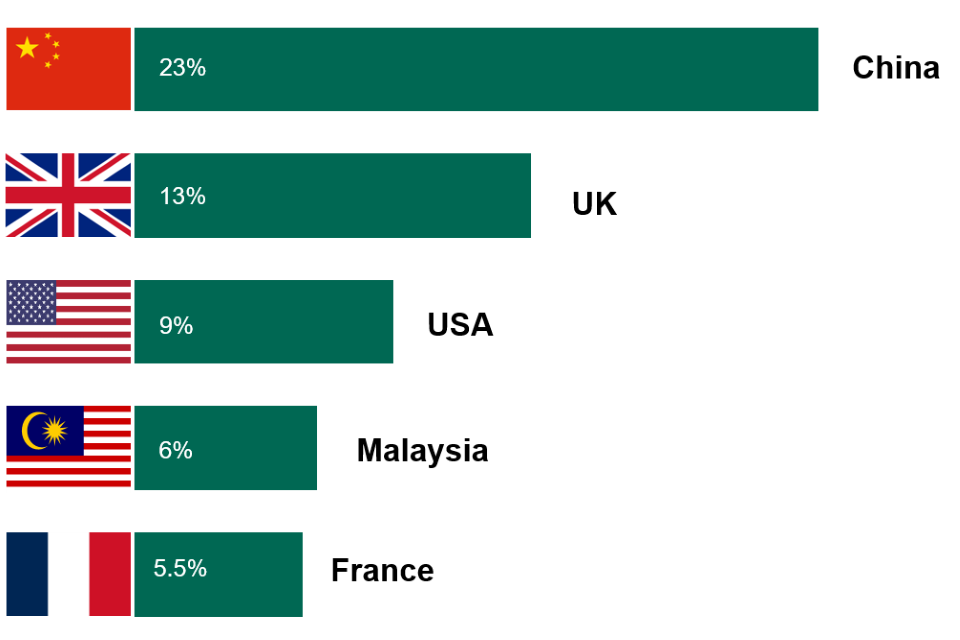
Development Fuel
Development Fuel - Specific fuels made from sustainable wastes or residues (excluding segregated oils and fats such as used cooking oils and tallow). These fuels are awarded development fuel certificates, which are double counted.
A specific target for ‘development fuels’ was introduced from 1 January 2019. This target takes into account the fuel types, production pathway and the feedstock. These fuels include aviation fuel, drop-in fuels, substitute natural gas and hydrogen (see notes and definitions).
The RTFO Administrator has verified 306 litres eq. of hydrogen and 141 thousand litres eq. of development petrol so far in 2020, which qualified as a development fuel. 100% of RTFO hydrogen is sourced from wind power in the UK. 85% of development petrol is sourced from sugar beet tops, tails, chips and process water from Ukraine with the other 15% coming from food waste from Poland.
Certificates Awarded Under the RTFO
Double Counting - Renewable fuel produced from waste feedstocks, crop residues and dedicated energy crops are incentivised by awarding double the RTFCs per litre or kilogram supplied.
Renewable Transport Fuel Certificates (RTFCs)
RTFCs are awarded to transport fuel suppliers whose renewable fuel meets the sustainability criteria. In 2020, 3,303 million RTFCs have so far been issued to 1,887 million litres eq. of renewable fuel. This is out of a total of 2,499 million litres eq. supplied so far in 2020.
Double Counting feedstock
Of the 3,303 million RTFCs awarded to renewable fuel that met the sustainability criteria, 2,836 million were issued to fuel from a waste/ residue or ‘Double Counting’ feedstock.
Figure 8: Renewable fuel to which RTFCs have been issued (Table RF_0102)
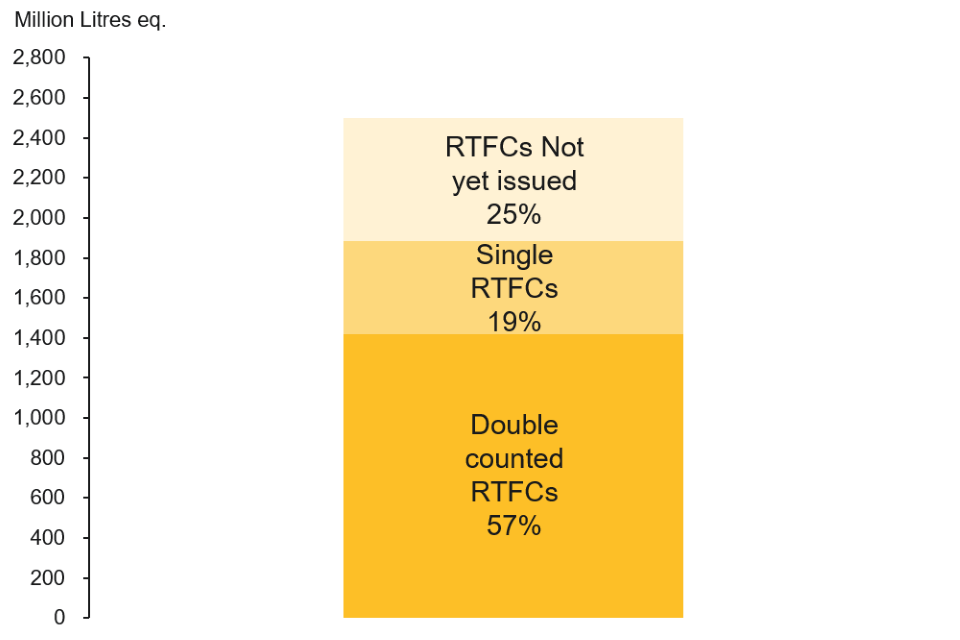
Obligations Under the RTFO
Verified Renewable Fuel - Verified renewable fuel refers to fuel that has received RTFCs for having met the Sustainability Criteria. For more, see the Notes and Definitions.
Sustainability Criteria - To receive Renewable Fuel Certificates, fuels supplied must meet the sustainability criteria set out in the amended Renewable Transport Fuel Obligations Order 2007 and the RTFO Carbon and Sustainability guidance. Renewable fuel must deliver minimum GHG savings and must not originate from land with high biodiversity value of carbon stock
Suppliers of fuel for road and non-road mobile machinery (for example, tractors) that supply 450,000 litres or more per year have an obligation under the RTFO Order. Obligated suppliers may meet their obligation by redeeming Renewable Transport Fuel Certificates (RTFCs) or by paying a fixed sum for each litre of fuel for which they wish to ‘buy-out’ of their obligation. RTFCs are gained by supplying sustainable renewable fuels. In 2020, such suppliers must redeem RTFCs and development fuel RTFCs (dRFTCs) for 9.6% and 0.15% of their share of total fuel, respectively. The RTFC target increase from 2021 onwards will be focused on increasing dRTFCs, to 2.8% in 2032.
One certificate may be claimed for every litre or kilogram of sustainable renewable fuel supplied. Fuel from certain wastes of residues, fuel from dedicated energy crops, and renewable fuels from non-biological origin (RFNBOs) are incentivised by awarding double the RTFCs per litre or kilogram supplied.
Companies have up to 5 months after the end of the year before they must apply for RTFCs. Partly as a result of this, 25% of renewable fuel so far supplied this year is not yet verified. Each provisional report typically has a higher proportion of renewable fuel which has been verified, and the final report describes all verified renewable fuel supplied in the year.
Background Information
Sources of data in this report
Data on volumes of fuel, Renewable Transport Fuel Certificates (RTFCs) (issues, redemptions, surrenders, transfers) and Carbon & Sustainability (C&S) are held by the Renewable Transport Fuel Obligation (RTFO) Administrator on the RTFO Operating System (ROS). Fuel volume data is submitted on a monthly basis by fuel suppliers to the RTFO Administrator and validated against HMRC duty payment data.
C&S data is only reported once RTFCs have been issued. There will therefore be a difference between the volume of renewable fuel supplied and the number of RTFCs issued and C&S data available. The final report for an obligation period will show the final position.
Further details
Further information on the data can be found in the notes and definitions.
Related information
Previously published reports can be found on the DfT website.
The publication timetable can be found at Annex B.
Renewable fuel mix reporting
The data reported by fuel suppliers under the RTFO is in line with mass balance rules. A mass balance system requires suppliers throughout the supply chain to account for their product on a units in - units out basis, but does not require physical separation of certified feedstock or fuel from uncertified material. It ensures that for every unit of sustainable renewable fuel sold, the corresponding sustainable feedstock has been produced. This can mean the actual feedstock mix might differ from that reported. Nonetheless, the feedstocks and renewable fuels reported in this document represent those that are incentivised and rewarded under the RTFO.
Strengths and Weaknesses of the data
C&S data is verified by independent verifiers and checked against the RTFO Guidance by the Administrator.
The Administrator validates volume data submitted by fuel suppliers against that held by the HMRC regarding fuel duty liabilities. Whilst the Administrator validates volume data against HMRC data at a company level, there is not an exact match between the volume of fuel reported in this report and the volume of fuel reported in HMRCs Hydrocarbon Oils bulletin. For further information see the notes and definitions.
Official Statistics
Official Statistics are produced to high professional standards set out in the Code of Practice for Statistics. However, these statistics have not been assessed by the Office for Statistics Regulation. Details of ministers and officials who received pre-release access to these statistics up to 24 hours before release can be found in the pre-release access list.
Annex A: Renewable Fuel Statistics Content of Tables
Renewable fuel statistical reports are published quarterly.
The final report for this reporting period (scheduled for publication in November 2021) will report on the carbon and sustainability performance of individual suppliers.
Table 1: Typical content of renewable fuel statistics tables
| Table | Previously reported as | Description | Provisional Report | Final Report |
|---|---|---|---|---|
| RF_0101 | RTFO_01 | Volume of fuel supplied | Yes | Yes |
| RF_0102 | RTFO_02 | Fuels issued with RTFCs and number of RTFCs issued | Yes | Yes |
| RF_0103 | RTFO_03 | RTFC balance by obligation period | Yes | Yes |
| RF_0104 | RTFO_04 | RTFC trades to date by company type | Yes | Yes |
| RF_0105a | RTFO_05 | RTFO wide carbon and sustainability data | Yes | Yes |
| RF_0106 | RTFO_06 | RTFO wide voluntary scheme data | Yes | Yes |
| RF_0105b | - | Feedstock and country of origin over time | No | Yes |
| RF_0107 | RTFO_07 | Performance against obligation by supplier | No | Yes |
| RF_0108a | RTFO_08a | Feedstock by supplier as a % of their supply | No | Yes |
| RF_0108b | RTFO_08b | Country of origin by supplier as a % of their supply | No | Yes |
| RF_0109 | RTFO_09 | % of renewable fuel that was sustainable by supplier | No | Yes |
| RF_0110 | RTFO_10 | Carbon and sustainability data by supplier | No | Yes |
| RF_0111 | RTFO_11 | RTFO wide fuel supply by volume and energy | No | Yes |
| RF_0112 | RTFO_12 | Civil penalties and other non-compliance | No | Yes |
| RF_0114 | - | Total greenhouse gas savings over time | No | Yes |
Annex B: Renewable fuel statistics reporting timescales
Table 2: Publication dates and contents of each report

Please contact Environment Statistics if you have any questions about DfT Renewable fuel statistics.
We are trialling this HTML format for our provisional renewable fuel releases, and we would like to hear your comments. If you have any feedback on our use of this format, or any questions about this release please email Environment Statistics.
